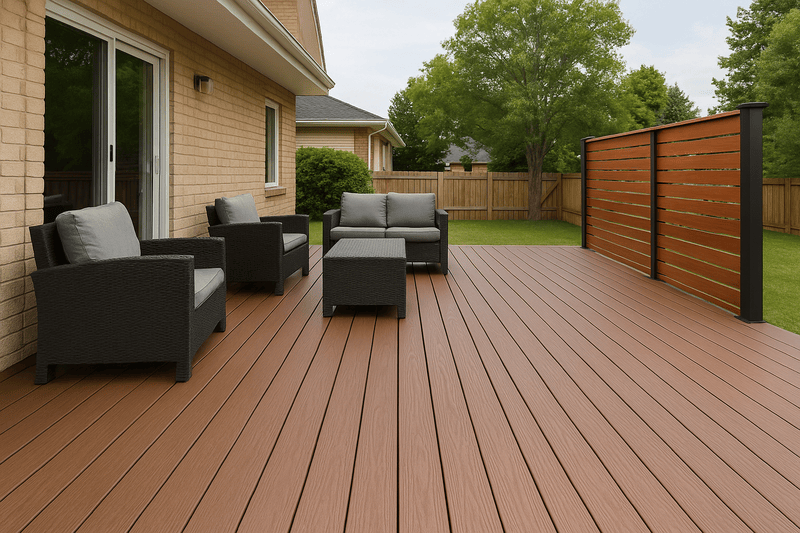
With outdoor living more valued than ever, homeowners across Sydney’s Eastern Suburbs are investing in long-term, low-maintenance solutions for their backyards. And right now, composite decking—also known as plastic decking—is gaining serious attention. But what’s behind the growing popularity of these materials, and is it worth choosing over traditional timber?
Whether you’re redesigning your alfresco area, adding a pool deck, or creating a multi-level entertainment space, understanding the benefits and limitations of composite materials may save you both time and money.
This article explores the practical reasons behind the rise of plastic and composite decking, common concerns, and what to consider before installing it.
What Is Composite Decking, and Why Is It So Popular?
Composite decking refers to boards made from a blend of wood fibres and recycled plastics. Sometimes referred to as WPC (wood plastic composite), it replicates the look and feel of timber without many of the common drawbacks.
The appeal lies in its durability and low upkeep. Unlike timber, it doesn’t need regular oiling, sanding, or staining. It resists splintering, won’t rot from moisture, and holds up well against Sydney’s UV exposure.
Builders like Vega Carpentry composite decking specialists are reporting an increase in demand from homeowners who are tired of constant maintenance and looking for something that holds its colour, shape, and structure year after year.
Key Benefits of Composite Decking in Sydney’s Coastal Climate
Living in the Eastern Suburbs means enjoying proximity to beaches, sea breezes, and sunny days—but it also means dealing with salt spray, humidity, and harsh sun. These factors can wreak havoc on traditional timber.
Here’s why composite materials are better suited to the region:
- UV resistance: Composite boards are built to resist fading from prolonged sunlight, making them ideal for exposed areas.
- Moisture tolerance: Because plastic decking doesn’t absorb water, it’s less likely to warp, rot, or develop mould—perfect for coastal homes or poolside installations.
- Termite-proof: One of the biggest risks to timber decks is termite damage. Composite materials are impervious to insects.
- Low maintenance: Just rinse with water or use a mild detergent—no staining, sealing, or sanding needed.
Homeowners who prefer to relax in their outdoor spaces rather than maintain them every season find these qualities particularly appealing.
Common Concerns About Plastic Decking—And the Facts
Despite its advantages, some people are hesitant about composite decking due to outdated assumptions. Let’s unpack a few:
“It looks too fake.”
Today’s products are far removed from the plastic-looking boards of the past. Many premium lines now feature natural grain textures, colour variation, and matte finishes that resemble real hardwood.
“It gets too hot underfoot.”
This can happen, but it depends on the product and colour. Lighter shades absorb less heat, and many brands have introduced cooling technology. Placement matters too—adding shade structures or pergolas can help keep surfaces cooler.
“It’s more expensive than timber.”
While upfront costs may be higher than some timber options, the long-term savings on maintenance and repairs often make composite the better value. There’s no need to factor in annual oiling, deck sanding, or replacing warped boards.
The Most Popular Applications for Composite Decking
In Sydney’s Eastern Suburbs, composite decking is being used creatively across various outdoor projects:
- Entertaining decks: For seamless indoor-outdoor living areas that remain tidy and durable
- Pool surrounds: Because composite doesn’t splinter or get waterlogged, it’s perfect near pools
- Balconies and rooftop decks: Lightweight options reduce structural load while still offering strength and stability
- Garden paths and courtyards: Adds a neat, modern edge that blends with outdoor landscaping
Each of these applications benefits from the material’s ability to retain its shape, resist damage, and provide consistent visual appeal.
How to Choose a Composite Decking Installer
A successful installation depends just as much on workmanship as it does on the product you select. Working with experienced professionals ensures your deck meets local council standards, performs well over time, and looks great from day one.
Vega Carpentry composite decking services are a strong example of this approach, offering expert installation across the Eastern Suburbs. Their team assesses your site, helps you choose the most suitable board profile, and installs with precision—reducing future risks like warping, uneven joins, or drainage issues.
Before booking a contractor, ask the following:
- Have they completed projects similar to yours?
- Do they offer product recommendations based on your specific location and needs?
- Can they handle council approvals if required?
- What aftercare support do they provide?
These questions will help you find a deck builder who sees your project not just as a job—but as part of your lifestyle.
Long-Term Value: What You Can Expect Over the Years
A well-installed plastic decking system will continue to look sharp with minimal effort. Unlike timber, which often deteriorates over time unless meticulously maintained, composite holds up against fading, scratching, and cracking.
Homeowners often report feeling the biggest difference during the second and third year of use—when a timber deck would normally be due for a clean, oil, or repair, composite surfaces still look fresh with only occasional hosing down.
If you’re planning to resell, modern decking adds appeal and function that buyers appreciate. A neat, functional deck that doesn’t hint at future maintenance work may help sway decisions during inspections.
To see how this type of decking blends with different home styles, visit visual examples in design collections or mood boards on Blogrip to find concepts suited to modern, coastal, or traditional homes.
Tips for a Successful Composite Decking Project
- Plan for ventilation. Ensure there’s airflow beneath the boards to prevent heat build-up.
- Mind your gaps. Composite materials expand and contract with temperature—your installer should leave space between boards accordingly.
- Choose the right fixings. Hidden fasteners can provide a sleek, clean finish without exposed screws.
- Match colours to surroundings. Consider home cladding, fencing, and furniture tones to create a cohesive palette.
You can explore Blogrip for design tips, renovation stories, and outdoor living articles to inspire your deck project planning.
Final Thoughts: Is Composite Decking Worth It?
For homeowners in Sydney’s Eastern Suburbs, composite and plastic decking offer a highly practical alternative to timber. While no material is perfect, composite ticks many boxes that traditional wood simply can’t: weather resistance, low upkeep, aesthetic consistency, and a long service life.
With professional installation from experienced teams like Vega Carpentry composite decking, your new outdoor area may remain one of the lowest-maintenance and most reliable parts of your property.

Leave a Reply